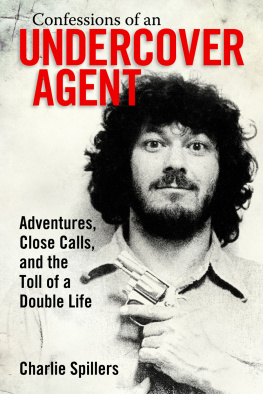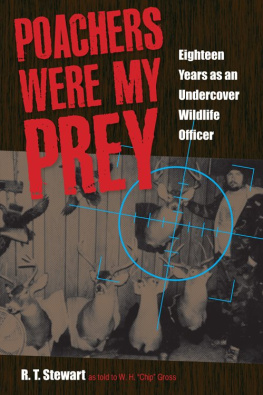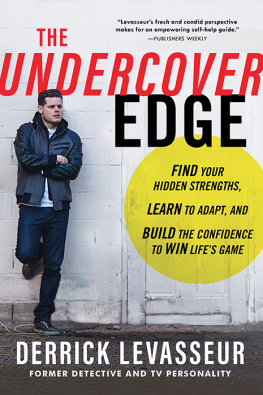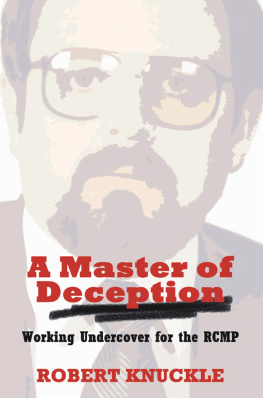Published in 2018 by
Lucent Press, an Imprint of Greenhaven Publishing, LLC
353 3rd Avenue
Suite 255
New York, NY 10010
Copyright 2018 Lucent Press, an Imprint of Greenhaven Publishing, LLC.
All rights reserved. No part of this book may be reproduced in any form without permission in writing from the publisher, except by a reviewer.
Designer: Deanna Paternostro
Editor: Siyavush Saidian
Library of Congress Cataloging-in-Publication Data
Names: McPhee, Edna.
Title: Undercover operations: investigating crimes from the inside / Edna McPhee.
Description: New York : Lucent Press, 2018. | Series: Crime scene investigations | Includes index.
Identifiers: ISBN 9781534560932 (library bound) | ISBN 9781534560949 (ebook)
Subjects: LCSH: Intelligence service--Juvenile literature. | Undercover operations--Juvenile literature. | Espionage--Juvenile literature.
Classification: LCC JF1525.I6 M37 2018 | DDC 327.12--dc23
Printed in the United States of America
CPSIA compliance information: Batch #BS17KL: For further information contact Greenhaven Publishing LLC, New York, New York at 1-844-317-7404.
Please visit our website, www.greenhavenpublishing.com. For a free color catalog of all our high-quality books, call toll free 1-844-317-7404 or fax 1-844-317-7405.
Contents
Foreword
Introduction:
Overt Op or Undercover?
Chapter One:
A Secret History
Chapter Two:
Who Are You?
Chapter Three:
Ways and Means
Chapter Four:
Gadgets and Gizmos
Chapter Five:
I, Spy
Notes
For More Information
Index
Picture Credits
About the Author
Foreword
F or decades, popular television programs and movies have depicted the life and work of police officers, detectives, and crime scene investigators. Most of these shows and films portray forensic scientists as the brains responsible for cracking cases and bringing criminals to justice. Undoubtedly, these crime scene analysts are an important part in the process of crime solving. With modern technology and advances in forensic analysis, these highly trained experts play a crucial component of law enforcement systems all across the world.
Police officers and detectives are also integral members of the law enforcement team. They are the ones who respond to 911 calls about crime, collect physical evidence, and use their high level of training to identify suspects and culprits. They work right alongside forensic investigators to figure out the mysteries behind why a crime is committed, and the entire team cooperates to gather enough evidence to convict someone in a court of law.
Ever since the first laws were recorded, crime scene investigation has been handled in roughly the same way. An authority is informed that a crime has been committed; someone looks around the crime scene and interviews potential witnesses; suspects are identified based on evidence and testimony; and, finally, someone is formally accused of committing a crime. This basic plan is generally effective, and criminals are often caught and brought to justice. Throughout history, however, certain limitations have sometimes prevented authorities from finding out who was responsible for a crime.
There are many reasons why a crime goes unsolved: Maybe a dead body was found too late, evidence was tampered with, or witnesses lied. Sometimes, even the greatest technology of the age is simply not good enough to process and analyze the evidence at a crime scene. In the United States during the 20th century, for example, the person responsible for the infamous Zodiac killings was never found, despite the earnest efforts of hundreds of policemen, detectives, and forensic analysts.
In modern times, science and technology are integral to the investigative process. From DNA analysis to high-definition surveillance video, it has become much more difficult to commit a crime and get away with it. Using advanced computers and immense databases, microscopic skin cells from a crime scene can be collected and then analyzed by a forensic scientist, leading detectives to the home of the culprit of a crime. Dozens of people work behind the scenes of criminal investigations to figure out the unique and complex elements of a crime. Although this process is still time-consuming and complicated, technology is constantly improving and adapting to the needs of police forces worldwide.
This series is designed to help young readers understand the systems in place to allow forensic professionals to do their jobs. Covering a wide range of topics, from the assassination of President John F. Kennedy to 21st-century cybercriminals, these titles describe in detail the ways in which technology and criminal investigations have evolved over more than 50 years. They cite eyewitnesses and experts in order to give a detailed and nuanced picture of the difficult task of rooting out criminals. Although television shows and movies add drama to the crime scene investigation process, these real-life stories have enough drama on their own. This series sticks to the facts surrounding some of the highest-profile criminal cases of the modern era and the people who work to solve them and other crimes every day.
Introduction
Overt Op or Undercover?
B eing an undercover agent sounds like something out of an action movie: a new wardrobe, a new name, and new way of doing an old job. Bob Cooke, a retired special agent with the California Department of Justice, described working undercover as the most thrilling job Ive ever had. [But] sometimes, it was also the most boring: long hours; days, weeks, or months of surveillance. Going undercover is not all excitement and action; a lot of time is spent earning the trust and friendship of the people who are under suspicion.
In the past 30 years, American organizations have improved their methods to protect their undercover agents. Now, undercover operations are as much about gathering information as they are about big, exciting takedowns. These new methods have helped guard the lives of the agents putting themselves at risk. Cooke reflected that these improvements were made as agencies learned from past mistakes:
Times changed, and we stopped doing business like that as we learned those operations were costing the lives of good men and women everywhere. We learned safer ways of conducting takedowns and arrests. [An undercover agent] should not be placed in any more danger that can be managed. Over the years, I was lucky enough to survive other violent situations where I was held at gun and knife point. We manage the risks by employing better tactics and policies.
In Cookes former field of narcotic enforcement, the department that deals with illegal drug trade, undercover operations are often used to track the sale of drugs to their source. To do that, an officer must be completely immersed in the world that they are infiltrating or joining. Big busts are generally the result of many months or years of groundwork.
The Enemy of an Enemy Is a Friend
The process of earning trust in the world of illegal activity, though often slow and difficult, can be the most important part of an undercover agents job. To do that, most agents need someone on the inside to vouch for themthese people are called confidential informants, or CIs. These assets are critical for undercover agents, even more so than false identities and good acting. As Cooke explained,
After a while, I realized that it didnt matter about the [disguise]. What mattered was how I could get close to someone involved in illegal activities Informants are either working for money or because they have a case pending against them and they want to [reduce] their sentence. CIs will either purchase drugs or guns for you or they will introduce an undercover (UC) officer/agent to the drug or firearms dealer. It is best to have the UC make the buys or the CI will have to testify in open court.












